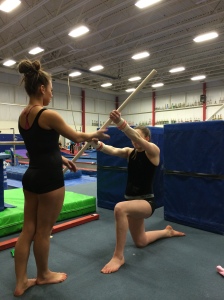The concept of the core is something that pops up in almost every gymnastics discussion, due to its role in skill work. In every gym you step foot into you’re bound to hear someone talking about tight cores, squeezing the belly hollow, and “doing abs” for conditioning. Every current or former gymnast reading this can vividly relate to the amazing but awful feeling of the seal stretch after what felt like 2 hours of hollow rocks. Granted this type of strength is really important for gymnastics, there is so much more information to the core relating to injury prevention and skill performance. In the last 6 months I have read an incredible amount of literature and books discussing what the core does for our every day lives, sports, and ways to train for safe movement. I have spent a lot of time processing the information and brewing up ideas about these ideas may change the way some people think about core training in gymnastics. Last week’s article about how a gymnast’s core problem can look like hamstring tightness got the most attention out of anything I have ever published. I wanted to follow that up and write about where my brain has been the last few months for core training in gymnasts. I also wanted to share some of the ways I have put these ideas into our pre-hab/strength programming for coaches and gymnasts to try out.
Tag Archive: core stability
Thoughts on Re-Thinking Core Training In Gymnastics
Tackling Faulty Lower Spine and Hip Posture In Gymnasts (Pt II): How To Address The Possible Contributing Issues
Last week in Part I of this topic, I went over some contributing factors to gymnasts developing chronic archy back, or anterior pelvic tilting. I also outlined how this may link to possible progressive/traumatic injuries, and decreased skill performance with gymnastics based skills. If the issue gets to the point where it causes an injury or pain, it is often times very frustrating for the gymnast. The then have to deal with the pain during daily activities, and they usually need to stop gymnastics while using PT to address the underlying issues. Patients of mine that are gymnasts with this issue unfortunately have progressed to the point they are in this situation, and are being forced to deal with the recovery aspect while missing their season. It is much better to address the issue very early during training in the gym, and hopefully prevent it before it gets to be too serious.

Improper Half Kneeling Hip Flexor Stretch – Note Anterior Pelvic Tilt and Compensatory Use of Lower Back Arch
There are definitely some ways that coaches and gymnasts can help to correct for this faulty lower body posture commonly seen. By far the biggest factor in this is being cognitively aware of it, and making sure athletes are actively trying to correct the problem during training. If the gymnast does not try to fix the problem when doing drills/skill, standing in line for turns, sitting in school, and through their daily activities, it will be very hard to fix the overall problem. All the stretches, myofascial work, and corrective exercises won’t get you anywhere if the athlete spends 12 hours a day hanging out in the arch back position.
Tackling Faulty Lower Spine and Hip Posture in Gymnasts (Part I): Links To Injury and Possible Contributing Factors
The very first post I ever put up on this blog was about hip flexor mobility restrictions, and it had some information related to improper posture in gymnasts. It concerned how a lack of hip flexor mobility can contribute to both decreased skill performance, and possibly some injuries. Although that is definitely one contributing factor for the typical lower back posture many athletes assume, there is a lot more to it that coaches and athletes can learn about. Due to it being so common with gymnasts, many members of the sport view it a natural part of doing gymnastics. However, it is not something that should just brushed over. I hope to educate readers about the possible reasons behind this lower spine/pelvis/hip posture, describe why it can be problematic for gymnasts, and discuss how to deal with some of the issues. During this weeks post I will break down some possible contributing factors gymnasts may have, and why it might lead to some not so fun situations related to skill performance/injuries. Here’s a common picture we probably all see, gymnasts waiting for turns hanging out in this type of archy posture. I happened to catch one of our girls in the background of a photo.
This type of posture can be linked to a few big issues like:
- Increased lower back stress during backward bending skills, and contributions to possible hyper mobility of the lower spine. This can lead to various sprains/strains of the spine, and possible slippage of the vertebrae if it becomes a habit.
- Decreased performance for bridge based skills (tumbling, bar releases, yerchankos) as well as for leaps, dance, and jumps requiring hip extension
- Increased risk of forceful back extension with landings, dismounts, and bounding or “jamming” the back (opening early in front skills, or 1 1/2 punch on floor for example). Which I can tell you from experience, feels just awful.
- Faulty dismounting and landing mechanics, which can then be linked to multiple other spine and lower leg problems
- Builds a base of faulty movement patterns for gymnastics skills and development, which gives coaches and gymnasts a major headache down the road when athletes struggle to undue the habits.































































